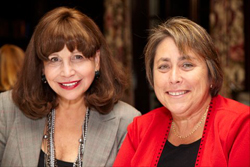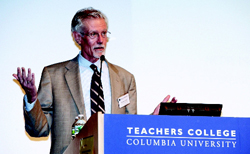First, Do No Harm
Experts say that to fill the technology jobs of the future, community colleges will need to overhaul and vastly improve their remedial literacy and math courses
Remedial courses for community college students often hinder rather than help
Half of all college students in the United States enter higher education at community colleges, making two-year institutions critical to the nation’s economic recovery. But in order to turn out enough graduates to fill the technology jobs of the future, community colleges will need to overhaul and vastly improve their remedial literacy and math courses. That was the message of a two-day conference on developmental education at TC on September 23 and 24, sponsored by the National Center for Postsecondary Research, which is based at the College, under the leadership, Thomas R. Bailey.
Bailey, the George and Abby O’Neill Professor of Economics and Education, and other speakers painted a discouraging picture of developmental education (the term that covers remedial coursework) in community colleges, where as many as 60 percent of new students are required to take remedial reading or math before they can move up to college-level courses. A majority of students who are steered to remedial courses do not take them and instead drop out of community college before they even start. Only 30 percent of remedial students complete their remedial courses, and only 25 percent of community college students earn degrees within six years—a statistic which, if not turned around, could stall or even kill an economic comeback.
Far from serving as a pathway to college, remedial, or developmental coursework “has largely been a barrier to success,” Martha Kanter, U.S. Under Secretary of Education, said in her keynote address. “We’ve seen students just fall out of the system, and we can’t allow that to happen.”
The solution, Kanter said, lies in research being done at Teachers College and elsewhere that can determine what works in developmental education and how to replicate success. “With enrollments bursting at the seams today and so much to accomplish to close the achievement gap, improve academic quality and increase college completion and success in the workforce and in life, research matters more than ever.”
But research is only effective if it is useful to teachers and administrators at community colleges and the high schools that feed them, Kanter said.
Similarly, curriculum is important, she argued, but it must be part of a support structure for students and teachers.
That point was echoed by a second keynote speaker, John Easton, Director of the Institute of Education Sciences, the research and evaluation arm of the U.S. Department of Education. Easton said the solution to ineffective developmental education lies not just in better programs but in fostering learning communities that support both students and teachers. And despite a trend in some circles of blaming teachers for the failure of schools, Easton said research on “what constitutes quality teaching, how to identify it and how better to train teachers, remains pretty thin.”
Schools and colleges need to be “learning organizations that value strong leadership; encourage and support innovation; use data for continuous improvement; hire good teachers and then support and develop them and encourage their collaborative efforts; make good programmatic decisions; and constantly tweak, refine and fix these programs as they need them,” Easton concluded.
The conference, which was attended by higher education researchers, community college practitioners and labor and education policymakers, featured discussion about which developmental education programs have been successful, and what the focus of future efforts should be. There was general agreement on the need to better align high school instruction with college curriculum, and on the importance of summer bridge programs, learning communities, and supplemental instruction. Discussion also focused on pedagogical research and classroom strategies, including context-based literacy instruction and alternative pathways from developmental math to statistics.
Bailey moderated a closing panel discussion with James Applegate of the Lumina Foundation, Ann Person of the Gates Foundation, and Kay McClenney, Director of the Center for Community College Engagement. The panelists agreed that much work lies ahead to improve developmental education and stressed the need to focus less on access to higher education, as has been the practice for decades, and more on outcomes such as completion and success, with special attention to low-income and under-represented students.
McClenney said she “took hope in the fact that we did get to a focus on quality teaching and the notion that teaching matters. Just try getting to higher graduation rates with high-quality degrees without attending to what goes on in classrooms between teachers and students.”
Published Wednesday, Oct. 13, 2010



